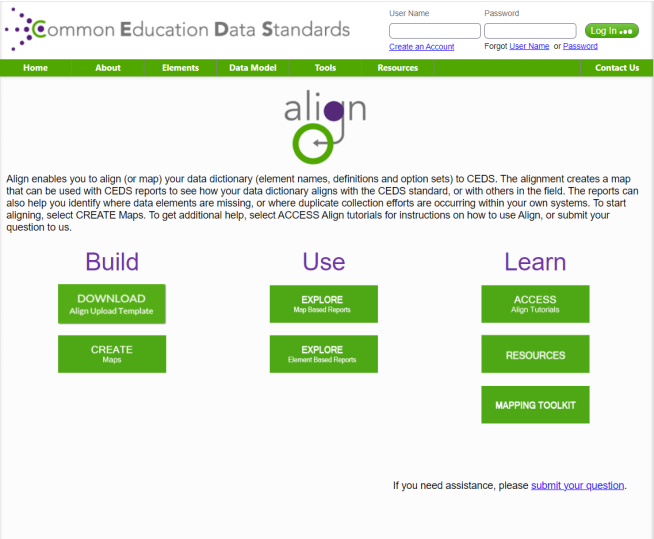Common Education Data Standards (CEDS)
Initiative
CEDS is an education data management initiative whose purpose is to streamline the understanding of data within and across P-20W institutions and sectors. CEDS includes a common vocabulary, data models that reflect that vocabulary, tools to help education stakeholders understand and use education data, an assembly of metadata from other education data initiatives and a community of education stakeholders who discuss the uses of CEDS and development of the standard. The CEDS Initiative is funded by the U.S. Department of Education’s National Center for Education Statistics. To learn more, see https://ceds.ed.gov/whatIsCEDS.aspx
Standards
The Common Education Data Standards (CEDS) are useful for data movement, data storage and data reporting. CEDS primarily supports a uniform set of data meanings and definitions. The CEDS data dictionary is a useful place to start when exploring this standard, as it serves to unify the meaning of data in a person, role, or organization data model. The data model will be discussed in the Tools section. CEDS supports and spans the entire P-20W+ range.
Tools
CEDS provides a freely available, fully extensible data model to support the implementation of a data warehouse. Below is verbatim information from the CEDS website that describes the various tools available to support CEDS adoption and implementation:
The CEDS Data Model includes a hierarchical schema of non-technical domains and entities with each CEDS element in context, and a fully-normalized logical model.
The Domain Entity Schema (DES)
The DES provides a user-friendly structure to easily identify elements organized by domain and entity. The domains for CEDS version 11 include:
- Early Learning
- Elementary and Secondary Education (abbreviated as K12)
- Postsecondary
- Career and Technical
- Adult Education
- Workforce
- Assessments
- Credentials
- Competencies
- Learning Resources
- Facilities
- Implementation Variables
- Authentication and Authorization
Later releases of CEDS will expand the domains and add additional elements and content within the current domains. Entities are commonly thought of as persons, places, events, objects, or concepts about which data can be collected. An entity provides context for a data element. Some examples of entities are Early Learning Child, K12 Student, K12 Staff, Postsecondary Student, Postsecondary Institution, etc. There are over 70 entities in the DES.
Helpful links to explore CEDS Entities and the Domain Entity Schema:
The Data Warehouse (DW)
Modeled for longitudinal storage and reporting of P-20W data, the Common Education Data Standards (CEDS) Data Warehouse implements star schema data warehouse normalization techniques for improved query performance.
Helpful link to explore the CEDS Data Warehouse: CEDS Data Warehouse
The Integrated Data Store (IDS)
CEDS supports standardizing educational organizations and their relationships with other organizations, people, and time. The Integrated Data Store is a reference model for operational implementations aligned to the CEDS standards. The P-20W focus of CEDS is supporting a transition from siloed, domain-specific, or location-specific, data sets to data that is compatible across domains and geographic boundaries. In addition to existing state and federal reporting and for analysis and comparison of aggregate statistics, the standards support data that moves with a learner from an early learning program to K12 to postsecondary to adult education and workforce learning programs. The latest release of CEDS also focuses on use cases that support people’s relationship with learning processes — the inputs, process steps (work), and outputs of learning — beginning with learning standards and assessments.
The IDS is a 3rd normal form structure organized around the key concepts of organization, person, and role. The IDS was developed with the goal of supporting physical implementations that could function as an “operational data store” for integrated P-20W data providing the most current available view of each organization, person, and role. The IDS starts with a flexible directory of organizations that may have multiple parent-child relationships with each other. People exist independently, but they do not have roles outside of their relationship to a specific organization for a specific date range. Each person shares common attributes, or data points, that allow us to represent all levels as ‘Persons.’ Each Person has one or more ‘roles.’ Roles are a time-aware association between a Person and an Organization.
At the intersection of organizations, persons, and learning resources are key learning processes. CEDS includes learning resources and process data elements definitions, such as learning standards, learning goals, learner assignments, learner activity, and learner achievements. Also defined in CEDS are the data elements and relationships covering formative, summative, and benchmark assessment processes.
Helpful link to explore the CEDS Integrated Data Store:
Data Model Documentation
Documents providing a printable representation of the CEDS Data Model, including entity relationship diagrams, case studies, and the normalized data schema tables and fields, can be found on the CEDStandards/CEDS-IDS GitHub repository in the /doc/ directory (https://ceds.ed.gov/dataModel.aspx).
Align
The Align tool enables users to align (or map) their data dictionary (element names, definitions and option sets) to CEDS. The alignment creates a map that can be used with CEDS reports to see how a user's data dictionary aligns with the CEDS standard, or with others in the field. The reports can also help users identify where data elements are missing, or where duplicate collection efforts are occurring within your own systems.
Connect
The Connect tool allows stakeholders across the P20W spectrum to address, define, and calculate metrics and indicators such as graduation rates, program enrollment, and academic outcomes. It allows users to define and analyze data used for reporting to the Federal government, and is an excellent tool for deconstructing policy or research questions. Connect gives users the ability to search through what others have done already, and includes reports designed to provide users with options for linking CEDS elements across Connections.
Connect's features are organized by the same Build, Use, and Learn supports that the Align tool provides.
JSON Wrapper
CEDS is currently developing an ontology of all elements within CEDS that will be capable of being expressed through JSON, XML, RDF, and other related standards.
